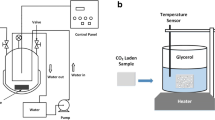Abstract
Thermal conductivity (λ) of a rigid polyurethane (PU) foam plays a vital role in determining the performance of thermal insulation. To accurately predict this property for a given recipe in a few seconds is the first step towards striking a balance between compressive strength, λ, and more properties of a foam product in industrial applications during formulation. What experimentally observed from PU closed-cell foams made from PAPI-27 Polymeric Methylene Diphenyl Diisocyanate (PMDI), Voranol 360, and n-pentane were: (1) foam shrinkage and even collapse occurred on both low (typically less than 0.9) and ultra-high (close to 2.0) indexes of isocyanate (IA); (2) to achieve the lowest λ for the best thermal insulation, it was suggested to use the highest IA without any foam shrinkage, the fastest stirring rate under safety, and the least physical blowing agent (PBA) until a sharp turn in the trend of λ; (3) there was a definite link between foam density (ρf), closed cell content (ccc), and λ: (a) a low λ requested a high ρf and ccc (b) a denser foam could be achieved by at least three ways. Increasing the agitation rate had a limit, above which the change in density became insignificant. However, a higher IA and reducing the amount of PBA had always been linear with ρf. (c) ρf was the cornerstone of ccc. In low ρf range, a growth of density gave rise to a distinct improvement of ccc, beyond which ccc reached a plateau for any higher density. The foam thermal conductivity during polymerization was successfully simulated by Matlab with 0.0157 % deviation. λ was initially dominated by the contribution from the resin mixture until the gel reaction time. Then, the dominant was shifted to the contribution by the gas component. The magnitude of thermal radiation was rather low throughout the reaction.
Similar content being viewed by others
References
Y. C. Tu, P. Kiatsimkul, G. Suppes, and F. H. Hsieh, Appl. Polym. Sci., 105, 453 (2007).
Y. C. Tu, G. Suppes, and F. H. Hsieh, Appl. Polym. Sci., 109, 537 (2008).
Y. C. Tu, H. Fan, G. Suppes, and F. H. Hsieh, Appl. Polym. Sci., 114, 2577 (2009).
H. Fan, A. Tekeei, G. J. Suppes, and F. H. Hsieh, Int. J. Polym. Sci., 2012 (2012).
W. Fang, Y. Tang, H. Zhang, and W. Tao, J. Wuhan Univ. Technol. Sci. Ed., 32, 703 (2017).
P. Ferkl, M. Toulec, E. Laurini, S. Pricl, M. Fermeglia, S. Auffarth, B. Eling, V. Settels, and J. Kosek, Chem. Eng. Sci., 172, 323 (2017).
H. Zhang, W. Z. Fang, Y. M. Li, and W. Q. Tao, Appl. Therm. Eng., 115, 528 (2017).
Y. Zhao, M. J. Gordon, A. Tekeei, F. H. Hsieh, and G. J. Suppes, Appl. Polym. Sci., 130, 1131 (2013).
Y. Zhao, F. Zhong, A. Tekeei, and G. J. Suppes, Appl. Catal. A Gen., 469, 229 (2014).
H. Al-Moameri, Y. Zhao, R. Ghoreishi, and G. J. Suppes, Ind. Eng. Chem. Res., 55, 2336 (2016).
R. Ghoreishi and G. J. Suppes, RSC Adv., 5, 68361 (2015).
Sigma-Aldrich, “TCPP, Mixture of Isomers” https:// www.sigmaaldrich.com/catalog/product/sial/32952?lang =en®ion=US.
Momentive Company, “Niax* Silicone L-6900” https:// www.momentive.com/en-US/categories/urethane-additives/ niax-silicone-l-6900/#.
Dow Plastics, PAPI-27 Polymeric MDI, Form No. PA-26-333-0301 (2001).
Dow Plastics, Voranol 360, Form No. 109–01273 (2001).
R. Herrington and K. Hock, “Dow Polyurethanes”, 2nd ed., pp. 2.2, Dow Chemical Company, 1997.
ASTM C518 (2015).
ASTM D1622 (2014).
ASTM D6226 (2015).
A. T. Huber and L. J. Gibson, J. Mater. Sci., 23, 3031 (1988).
J. R. Dawson and J. B. Shortall, J. Mater. Sci., 17, 220 (1982).
N. C. Hilyard and A. Cunningham, “Low Density Cellular Plastics: Physical Basis of Behaviour”, pp.115–124, Chapman & Hall, 1994.
M. C. Hawkins, B. O’Toole, and D. Jackovich, J. Cell. Plast., 41, 267 (2005).
L. J. Gibson and M. F. Ashby, “Cellular Solids: Structure and Properties”, 2nd ed., pp.202–207, Cambridge University Press, 1997.
B. E. Poling, J. M. Prausnitz, and J. P. O’connell, “The Properties of Gases and Liquids”, 5th ed., pp.10.56–10.64, McGraw-Hill, 2001.
C. L. Yaws, “Handbook of Transport Property Data: Viscosity, Thermal Conductivity, and Diffusion Coefficient of Liquids and Gases”, p.68, 96, Gulf Publishing Company, 1995.
S. Devotta and V. R. Pendyala, Ind. Eng. Chem. Res., 31, 2042 (1992).
Wikipedia, “Joback Method”, https://en.wikipedia.org/ wiki/Joback_method.
M. Nagvekar and T. E. Daubert, Ind. Eng. Chem. Res., 26, 1362 (1987).
S. An, L. Shen, and G. J. Suppes, Fiber. Polym., 18, 1031 (2017).
A. L. Lindsay and L. A. Bromley, Ind. Eng. Chem., 42, 1508 (1950).
J. D. Pandey and S. R. Prajapati, Procedings of Indian National Science Academy, 45, 372 (1979).
Y. Nawab, P. Casari, N. Boyard, and F. Jacquemin, J. Mater. Sci., 48, 2394 (2013).
H. Al-Moameri, R. Ghoreishi, Y. Zhao, and G. J. Suppes, RSC Adv., 5, 17171 (2015).
F. P. Incropera, D. P. Dewitt, T. L. Bergman, and A. S. Lavine, “Fundamentals of Heat and Mass Transfer”, 6th ed., pp.587–590, John Wiley & Sons, Inc., 2007.
Author information
Authors and Affiliations
Corresponding author
Rights and permissions
About this article
Cite this article
An, S., Suppes, G.J. & Ghosh, T.K. Simulation of the Optimized Thermal Conductivity of a Rigid Polyurethane Foam during Its Foaming Process. Fibers Polym 20, 358–374 (2019). https://doi.org/10.1007/s12221-019-8703-8
Received:
Revised:
Accepted:
Published:
Issue Date:
DOI: https://doi.org/10.1007/s12221-019-8703-8




